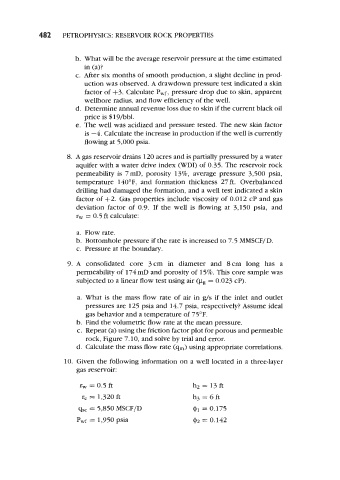Page 514 - Petrophysics
P. 514
482 PETROPHYSICS: RESERVOIR ROCK PROPERTIES
b. What wiU be the average reservoir pressure at the time estimated
in (a)?
c. After six months of smooth production, a slight decline in prod-
uction was observed. A drawdown pressure test indicated a skin
factor of +3. Calculate P,f, pressure drop due to skin, apparent
wellbore radius, and flow efficiency of the well.
d. Determine annual revenue loss due to skin if the current black oil
price is $19/bbl.
e. The well was acidized and pressure tested. The new skin factor
is -4. Calculate the increase in production if the well is currently
flowing at 5,000 psia.
8. A gas reservoir drains 120 acres and is partially pressured by a water
aquifer with a water drive index (WDI) of 0.35. The reservoir rock
permeability is 7mD, porosity 13%, average pressure 3,500 psia,
temperature 140"F, and formation thickness 27 ft. Overbalanced
drilling had damaged the formation, and a well test indicated a skin
factor of f2. Gas properties include viscosity of 0.012 cP and gas
deviation factor of 0.9. If the well is flowing at 3,150 psia, and
r, = 0.5 ft calculate:
a. Flow rate.
b. Bottomhole pressure if the rate is increased to 7.5 MMSCF/D.
c. Pressure at the boundary.
9. A consolidated core 3cm in diameter and 8cm long has a
permeability of 174 mD and porosity of 15%. This core sample was
subjected to a linear flow test using air (ps = 0.023 cP).
a. What is the mass flow rate of air in g/s if the inlet and outlet
pressures are 125 psia and 14.7 psia, respectively? Assume ideal
gas behavior and a temperature of 75'F.
b. Find the volumetric flow rate at the mean pressure.
c. Repeat (a) using the friction factor plot for porous and permeable
rock, Figure 7.10, and solve by trial and error.
d. Calculate the mass flow rate (qm) using appropriate correlations.
10. Given the following information on a well located in a three-layer
gas reservoir:
r, = 0.5 ft h2 = 13 ft
re = 1,320 ft h3=6ft
qsc = 5,850 MSCF/D @i = 0.175
Pwf = 1,950 psia @2 = 0.142

